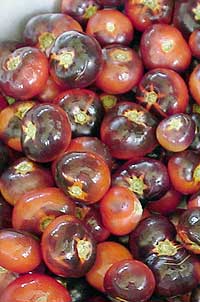Corwallis, Oregon
February 19, 2004
 Researchers
at Oregon
State University (OSU) have created purple-fruited
tomatoes that include anthocyanins – the same class of
health-promoting pigments in red wine that function as
antioxidants and are believed to prevent heart disease. Researchers
at Oregon
State University (OSU) have created purple-fruited
tomatoes that include anthocyanins – the same class of
health-promoting pigments in red wine that function as
antioxidants and are believed to prevent heart disease.
Their research is featured as
the cover story in the latest issue of the
Journal of Heredity.
Domestic tomato varieties grown
and consumed in the United States do not normally produce fruit
containing any anthocyanin, explained Jim Myers, OSU's Baggett
Frazier professor of vegetable breeding. The success in
producing anthocyanin-containing tomatoes – through traditional
breeding techniques – could help researchers develop even more
new varieties of tomatoes with other nutrients, both for home
gardeners and for the food industry, he added.
"Tomatoes are second only to
the potato in terms of the top vegetable consumed in the world,"
Myers said. "Per capita use in the U.S. in 2003 was 89 pounds of
tomatoes per person. If we could boost the nutritional value of
tomatoes, a large part of the population would benefit from
that."
The OSU researchers
accomplished the feat through the characterization of the
inheritance pattern of a little studied gene in tomatoes called
"anthocyanin fruit," or Aft. Myers and his OSU graduate students
crossed a domestic tomato plant with a genetic stock of tomato
that included a gene incorporated from a wild relative with
anthocyanin-containing fruit and the Aft gene. The result: a
domestic-type tomato fruit containing the purple pigment and the
Aft gene, thereby opening the door towards developing
anthocyanin-rich tomatoes.
Assisting Myers were graduate
students Carl M. Jones, now at the University of
California-Davis, and Peter Mes. The OSU researchers grew the
seeds of their new cross of anthocyanin tomato fruit in the OSU
research greenhouse for two generations, backcrossing them with
the original parent types. This work led them to confirm that
anthocyanin fruits are transmitted in tomatoes by a single
dominant gene, Aft.
"We are learning about how
anthocyanin genes are expressed in tomatoes, and how we might
cross tomatoes to get more nutritional value," explained Myers.
Comparing chemical analyses of
the tomatoes with the Aft gene to those without the gene, the
OSU plant breeders determined the pigment composition of
anthocyanin fruit gene, explained Myers. They also verified that
indeed, having fruits containing anthocyanin could be inherited
through a single gene, Aft.
Anthocyanins are the source of
the blue, purple and red in berries, grapes and some other
fruits and vegetables. These pigments also function as
antioxidants, believed to protect the human body from oxidative
damage that may lead to heart disease, cancer and aging,
explained Mes.
Working with Myers on his
doctoral research, Mes is breeding new crosses of tomatoes and
analyzing the antioxidant activity of not only anthocyanins in
the fruits, but also carotenoids, another class of beneficial
phytonutrients. He is also conducting preliminary nutrition
studies on humans that have consumed different types of his
tomatoes as juice, to see how the various carotenoids are
metabolized and which carotenoids prevent oxidation in human
plasma.
Industry is interested in their
work with higher nutrient tomatoes, say Mes and Myers.
"The medical, the nutritional
and the food research industries all are keenly interested in
the health benefits of phytochemicals in all sorts of fruits and
vegetables," said Myers. "We are happy to find out we can
accomplish this in tomatoes using traditional, classical plant
breeding techniques."
For more than 40 years, OSU
vegetable breeders W.A. Frazier, James Baggett and now Myers,
the current OSU Baggett-Frazier Professor of Vegetable Breeding,
have developed more than a dozen tomato varieties for commercial
and home growers around the world. |